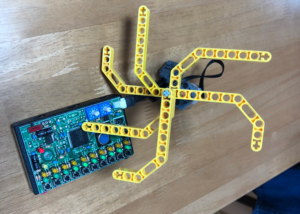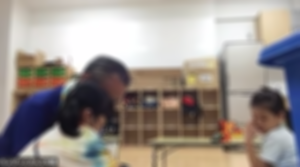A remote workshop was held at a school children’s club.
This time we used the 10-button version of the programmable battery to create our work. This programmable battery uses 10 buttons to turn the motor on and off so that you can be more aware of programming the movement of the motor. I first introduce the sample work and a simple way to use the programmable battery, but many students enjoy turning it all on first and spinning it around and around to get it moving. We will vary the movement as we add off pieces to further develop the piece.

We also prepared more blocks this time as materials for making artworks. As you all know, the good thing about blocks is that they can be easily attached and detached. In other words, you can experiment with any idea that comes to mind and give it shape.
You can see through the camera as the work keeps changing. The programmable battery we used last time is small and has a low output to the motor, so it is not powerful enough to move a large tire or a piece of work made of Lego. This version of the programmable battery is interesting because it can move such large objects. On the other hand, the previous programmable battery is small enough to be incorporated into a craft. The goal is to use them well together with the materials used in different workshops.
I am inside a Zoom-connected iPad and the local children appear to be participating (I have a projector showing them what it looks like). Once again, the students were proactive in showing me their work and discussing their creations with me in the iPad. Interacting with the children in this way, I felt as if I was conducting a workshop face to face.

Although the remote workshop has revealed many possibilities, there are also many challenges. First of all, we had many equipment troubles this time. The most difficult part of a remote workshop is to deal with problems. If equipment problems occur frequently, we cannot investigate the causes because we are not able to respond to them ourselves on site, and as a result, we cannot afford to run the workshop. This is also true for face-to-face workshops, but the lack of time and mental capacity makes it difficult to find out where the trouble is with the equipment. In addition, the workshop itself progresses in a panic. I call this equipment panic. When I first started the workshop, I suffered from this equipment panic many times. In fact, this is the time when we should have had the opportunity to make the most of our “programming mindset.
This time, I was clearly unprepared. I didn’t check the equipment enough before sending it, I took a lot of time to select what materials to send for the first remote workshop using this tool, and I got sick (first time I got the new coronary disease) at the time of workshop preparation, but these are not excuses. We need to prepare a schedule with enough time to prepare in advance, taking into account these factors and the time required for mailing. In this area, I may still be in the habit of preparing for face-to-face workshops. We will have to rethink how to schedule it. On the other hand, although we tested negative for new coronas on the day of the workshop, we might have had to cancel the workshop itself in the face-to-face workshop. This may be a unique advantage of remote workshops.
I walk around the floor during each workshop so that I can work with as many children as possible (10,000 to 20,000 steps including preparation), but it is also a challenge that I cannot move around in my iPad, There is inevitably a bias in the number of children you can engage. I am very happy that children want to talk to me, the facilitator, during the workshop, and I want to cherish that feeling, but I would like to think about how to engage with more children. This time, I first tried to talk to the children while carefully watching the camera images so as not to miss the occasional child who came up to me with a work of art.

Once again, we realized that remote workshops would not be held without the cooperation of local teachers and staff. If we increased the equipment and materials used in the workshop as we did this time, we would have placed an additional burden on the local teachers and staff. We would like to reconsider the equipment and materials for the workshop, taking into consideration the equipment and materials, the burden on the participants, and most importantly, the enrichment of the children’s artwork creation.
Last but not least, just as in the face-to-face workshops, we were able to experience an indescribable sense of fulfillment after the workshop was over. I would like to thank everyone involved. Thank you again.
